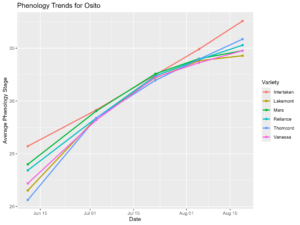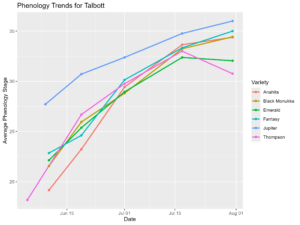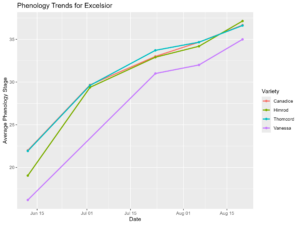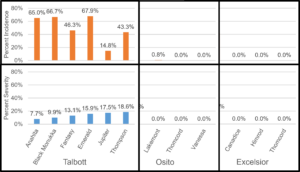Progress report for OW24-007
Project Information
Table grapes are a niche crop in the United States, accounting for 36% of all grape production, primarily in California. There is increasing producer interest and consumer demand for local table grape production, especially certified organic. Small and large fruit producers alike in Western Colorado are hoping to enter this market. Based on exploratory surveys, table grapes fetch a high price per pound and depending on the variety, can perform well in our high elevation environment, suggesting it can be a viable alternative crop for this region for both economic and agronomic reasons. Producers are now asking for support for selection of the best varieties for both environmental conditions and consumer preference. Due to our alkaline soil, irrigation constraints, and unpredictable fall and spring freeze events, selection of cultivars ideal for Colorado is a complicated endeavor. At the Colorado State University’s Western Colorado Research Center at Rogers Mesa, we have collected four years of preliminary data on 26 table grape varieties. Using this knowledge, we hope to revitalize this experiment with newly released varieties and the top performers from the previous trial. Additionally, with cooperation from our participant producers, we will measure plant health, crop yield, cold tolerance, and consumer taste preferences on using established vineyards. We will share these results and facilitate open collaboration between producers interested in pursuing this unique alternative crop. This project will help to expand the options for producers in our unique climate and inform the public on best organic practices for table grape production.
Project Objective 1: Perform data collection on table grape variety performance and vineyard management on participant producer land and a newly established variety trial at the Western Colorado Research Center at Rogers Mesa.
Project Objective 2: Collect consumer preference data through hosting taste tests at public and CSU-led events.
Project Objective 3: Create and distribute research results, training modules, and educational seminars via social media, fact sheets, workshops, videos, and conferences.
Year 1
We will initiate data collection on selected varieties from participant producers’ vineyards. Tissue tests will be taken on participant vineyards. Preparations will begin at WCRC-RM for planting a variety trial in spring 2025. Soil tests will be taken at all vineyard locations. A survey of current table grape acreage status will be initiated by the Extension viticulture professional. We will begin our first taste testing at public events and CSU SPUR 2nd Saturday. We will also start our webinar series (2 per year) with the first two being in Oct. and Nov. 2024.
Year 2
We will establish the variety trial at WCRC-RM. We will resume data collection of participant vineyards. Annual tissue tests per variety at WCRC-RM will initiate and participant vineyard tissue tests will continue. We will continue the annual tastings. The pruning demo video will be recorded. At the end of year 2, with 2 years of participant vineyard variety data, we will present at the annual Western Colorado Horticultural Society/VinCO Annual Meeting in Grand Junction, CO. We will host a pruning workshop and variety demonstration at WCRC. We will continue the webinar series.
Year 3
We will continue variety data collection and annual tissue tests in participant vineyards and the WCRC-RM variety trial. Taste testing will continue as well. Along with holding a pruning workshop, variety demonstration, master gardener training, and two webinars in March and May, we will compile and publish CSU Extension Fact Sheets on table grape production and choosing varieties. Additionally, we will add a table grape chapter to the renewed Colorado Grape Growers Guide. We will present again at the WCHS/VinCO conference.
Cooperators
- - Producer
- - Producer
- - Producer
Research
Objectives
Obj. 1: Evaluate table grape varieties and record management methods on participant producers’ vineyards.
Table grapes are not a completely unknown crop to Western CO growers. Producers that are already pursuing this alternative crop have valuable knowledge and wisdom for others interested in the process. We will collect data on variety performance on their vineyards, but we will also learn from these producers on how to best manage table grapes, and what varieties work for them. Producer cooperation is emphasized in this objective.
Outcome: An established cooperative relationship with participant producers. Knowledge on variety performance in different agricultural contexts to be presented to the community.
Obj. 2: Establish a new table grape variety trial at WCRC-RM
The WCRC-RM is a hub for education as well as research. Establishing a new variety trial with best performers from previous results and grower input, along with the latest breeding lines from reputable programs such as University of Minnesota, will allow us to be leaders in Western CO table grape research and consultation. Additionally, it will be a site for educational workshops for management practices and how to troubleshoot issues in production.
Outcome: Reliable results from rigorous scientific experimentation that is disseminated through reports, pamphlets, and social media. Producers will have a dependable resource to gather understanding on how to grow this alternative crop.
Obj 3: Tabling grapes: Which table grape varieties are most appealing to Colorado consumers?
Agronomic performance is important to know, but consumer preference is just as essential when selecting table grape varieties for this region. We will obtain data from members of the public at multiple events during harvest in all three years of the project. We will allow people to taste the different varieties and vote for each on a “likeability” scale.
Outcome: These events are both engaging and informative which will increase consumer awareness of local table grapes and provide producers with data on what varieties are most desired.
Experimental Locations
Western Colorado Research Center at Rogers Mesa, Colorado State University, Hotchkiss, CO
As a 100% Certified Organic research center, WCRC-RM serves as a nationwide knowledge hub for organic agriculture in arid climates. Located in Hotchkiss, CO, the 80-acre property has 30 irrigated acres, a climate-controlled greenhouse, and equipment and infrastructure supporting fruit tree orchards, grape vineyards, perennial pasture, and vegetable production. Their vision adheres to pertinent issues faced by growers, and 100% of the produce is donated to hunger relief organizations. Research topics include ecological pest and disease management, variety and rootstock trials, and regional adaptation of annual crops.
Participant producers
Talbott’s Mountain Gold, 3782 F-1/4 Road, Palisade, CO 81526
- Contains a 0.65-acre table grape vineyard with 9 different varieties.
Excelsior Orchard, 14140 Dry Gulch Rd, Paonia, CO 81428
- Contains a 1-acre table grape vineyard with 4 different varieties
Osito Farms, 11550 3100 Rd, Hotchkiss, CO 81419
- Contains a 2-acre table grape vineyard with 3 different varieties
Materials and Methods
Obj. 1 – Participant producer variety & management data collection
Data collection protocols at each participant producer’s vineyard will vary depending on physical layout, number of varieties, and established management practices. In general, we will select five randomly distributed blocks of 3-5 vines per block for data collection per variety for the duration of the project (years 1-3). CSU staff will visit the producers’ vineyards a minimum of five times during the growing season. During these visits, the following metrics will be recorded: Trunk survival and bud break (April – May), fruiting shoots and cluster numbers (May during bloom, August prior to harvest), disease/pest presence (May – July), fruit quality (August – Sept., during harvest), and yield at harvest. Components of fruit quality will include soluble solids (Brix %) and berry size. Yield will consist of cluster weights, total weight per vine, and estimated per acre yields based on replicate block averages.
Alongside the gathering of horticultural data described above, we will monitor nutrient status of the vines with annual petiole tissue testing (during veraison, years 1-3). The protocol involves selecting 75-100 petioles of recently matured leaves across 25-50 vines. This data will illustrate participant vineyard’s nutrient sufficiency/deficiency. A soil sample will be taken in each participant vineyard at the start of the project to assess pH, salinity, nutrient content, organic matter, and soil type. Other practices, such as irrigation methods and timing, pruning, fertilization, pest management, and vineyard floor management will be recorded for each site as well. Associating management methods with soil and tissue tests will provide pertinent information regarding best practices across multiple contexts and grape varieties.
Obj. 2 – Establishing the table grape variety trial at WCRC-RM
The establishment of a new table grape variety trial at WCRC-RM will allow for more detailed and long-term observation of varieties that are the most promising for producers interested in growing this crop. In the first year, we will prepare for vine planting targeted for spring 2025 (year 2). The trellis structure and irrigation are already installed from a previous planting that was removed. Irrigation emitters are micro-sprinklers (18.4 gal./hr), 10 feet apart in-row, and 2-3 feet high. Alleyways between the vine rows were seeded with buckwheat in Fall 2023 to compete with weeds. In spring 2024, alleyways will be cultivated and seeded with a perennial cover crop mixture and irrigated as needed through the 2024 growing season.
Variety selection for this trial will be based on previous data collected at WCRC-RM and the latest varieties from the University of Minnesota breeding program. Based on previous performance results at WCRC-RM, varieties under consideration are “Einset” (red), “Everest” (blue), “Himrod” (green), “Swenson Red” (red), and “Thomcord” (blue). Pre-releases from the UMN breeding program that show promise for our climate and soil are “MN1296” (red), “MN1369” (green), and “MN1325” (blue). We will also interact with our participant producers to get their input on our variety selection.
Before planting, we will perform a bulk soil test to assess initial soil characteristics. Vines will be planted in spring 2025 (year 2) at a spacing of 5 feet within rows, 10 feet between rows. Each variety will be distributed in a randomized complete block design, with each row as a block with plots of five vines per variety, totaling in five rows, each 200 feet long. Irrigation will be monitored via flow meters and duration estimated by crop evapotranspiration data (weather station on-site). Freshly planted vines will be watered frequently (up to 1” weekly, depending on precipitation). Fertility will be applied as needed based on soil and tissue tests using organic composted chicken manure and other organic nutrient products. As vines develop in year 2, we will begin to measure relevant variables as described above in our participant producer data collections. Tissue tests for each variety will be sampled annually (years 2+3) in the trial at WCRC-RM to assess variety-specific differences in nutrient uptake.
Obj. 3 – Consumer preference data by taste testing
An important element when assessing the potential of a new alternative crop such as table grapes is consumer preference. To assist growers in understanding what varieties would be most desirable to their buyers, we will perform taste tests at public events both community-organized and led by CSU. At these events, which will occur around harvest time during all three years of the project, we will provide varieties to taste and ask attendants to rate each variety by voting. The voting will use a method adopted by other successful variety trials at WCRC-RM, which provides three options: Love, Like, Dislike. These votes are done using color-coded chips placed into concealed voting boxes. Afterwards, the results will be tallied and presented as % votes for each of the three preference categories. Venues for this data collection will be at the Arbol Farmers Market in Paonia, the Annual Field Day at WCRC-RM, Mountain Harvest Festival in Paonia, and the Open House at CSU Western Campus in Grand Junction, CO, to name a few. Additionally, we will cooperate with the CSU SPUR campus in Denver, CO to include table grape varieties in their “2nd Saturdays” event where they open the campus to families and the public and provide food tastings.
Obj. 1 – Participant producer variety & management data collection
Phenology graphs for three participant producer vineyards in 2024. Phenology stages are based upon (https://flgp.cce.cornell.edu/submission.php?id=58). Measurements were taken every two weeks from June through August (until harvest). Values were averaged at each vineyard within 7 blocks per variety, 3 vines per block.
| Fruiting shoots | Av. clusters per shoot | Av Clusters per vine | Total Harvest | Marketable Harvest | Theoretical Economic loss (per ac) | ||||||||
| Vineyard | Variety | Tot. Weight (g) | Av vine weight (lb) | Per Ac (8x10)(lb) | Price per ac. ($4) | Tot. Weight (g) | Av vine weight (lb) | Per Ac (8x10)(lb) | Price per ac. ($4) | ||||
| Talbott | Anahita | 4.1 | 1.0 | 5.9 | 13802 | 5.2 | 2834.7 | $11,338.9 | 9979 | 3.8 | 2049.5 | $8,198.1 | -$3,140.7 |
| Black Monukka | 9.0 | 1.1 | 10.3 | 47169 | 10.1 | 5484.5 | $21,938.1 | 20100 | 4.3 | 2337.1 | $9,348.4 | -$12,589.7 | |
| Fantasy | 9.1 | 1.1 | 12.9 | 29391 | 5.0 | 2736.5 | $10,945.8 | 9054 | 1.5 | 843.0 | $3,371.9 | -$7,573.9 | |
| Emerald | 14.5 | 1.1 | 22.7 | 82463 | 8.0 | 4362.0 | $17,447.9 | 0 | 0.0 | 0.0 | $0.0 | -$17,447.9 | |
| Jupiter | 31.8 | 2.1 | 81.6 | 167642 | 4.5 | 2469.3 | $9,877.1 | 59979 | 1.6 | 883.5 | $3,533.8 | -$6,343.3 | |
| Thompson | 11.0 | 1.1 | 13.0 | 56476 | 9.6 | 5238.9 | $20,955.5 | 41396 | 7.0 | 3840.0 | $15,360.0 | -$5,595.5 | |
| Excelsior | Canadice | 15.4 | 1.2 | 19.3 | 53044 | 6.0 | 3296.5 | $13,186.0 | 53044 | 6.0 | 3296.5 | $13,186.0 | $0.0 |
| Himrod | 21.0 | 1.1 | 20.8 | 0 | 0.0 | 0.0 | $0.0 | 0 | 0.0 | 0.0 | $0.0 | $0.0 | |
| Thomcord | 25.5 | 1.1 | 24.6 | 112760 | 10.1 | 5512.1 | $22,048.3 | 77553 | 7.0 | 3791.0 | $15,164.2 | -$6,884.1 | |
Table of harvest metrics from two locations for 2024. Information for the third location (Osito) is still being provided by the participating vineyard and the results from Excelsior Himrod were lost due to miscommunication during harvest. The total harvest weights are calculated from all fruit per vine. The marketable harvest weights are calculated by removing all fruit that would not meet grade standard (fruit showing signs of scarring, bird/insect injury, sunburn, or disease). The weight per acre was calculated with the assumption that vines are placed 8 ft apart and rows are 10 ft apart for a total of 545 vines per acre and the $4 per lb assumption is based on reported sales from participating farmers. Bolded numbers are the highest in each section for each location.
Stacked graphs of disease incidence (orange) and disease severity (blue) on grape leaves. Disease incidence represents the presence or absence of powdery mildew on a leaf and disease severity is the percentage of leaf covered in powdery mildew (top and bottom surfaces). Values were averaged at each vineyard within 6 blocks per variety, 20 leaves across 4 cordon per block.
Obj. 3 – Consumer preference data by taste testing
| Tasting event | Variety | Total Tasters | Love | Like | Dislike |
| Rogers Mesa Field Day | Fantasy | 59 | 71.2% | 23.7% | 5.1% |
| Jupiter | 61 | 78.7% | 11.5% | 9.8% | |
| Thompson | 50 | 38.0% | 52.0% | 10.0% | |
| Arbol Market | Anahita | 40 | 50.0% | 45.0% | 5.0% |
| Canadice | 41 | 48.8% | 36.6% | 14.6% | |
| Emerald | 37 | 43.2% | 51.4% | 5.4% | |
| Himrod | 39 | 35.9% | 30.8% | 33.3% | |
| Thomcord | 39 | 69.2% | 23.1% | 7.7% | |
| Thompson | 34 | 64.7% | 32.4% | 2.9% |
Results of consumer preference events at two venues of different harvested varieties. These were conducted using a preference selection marker for "love", "like", and "dislike." These were designated by colored chips, which were placed in closed voting boxes. The percentages of the three markers were calculated to provide a general assessment of varieties. Bolded numbers are the highest in each section for each location.
Research Outcomes
Nothing yet, though we have developed some recommendations of varieties that may work best for regions in Mesa and Delta Counties, Colorado.
Education and Outreach
Participation Summary:
A majority of our education and outreach activities are occurring in 2025 and 2026. In 2024, we conducted simple taste tests to assess consumer preference of different harvested varieties. These were conducted using a preference selection marker for "love", "like", and "dislike." These were designated by colored chips, which were placed in closed voting boxes. The percentages of the three markers were calculated to provide a general assessment of varieties. In 2025 and 2026, we plan to hold formal tastings which specify details such as flavor, texture, and firmness. These criteria have been developed during 2024 for use in the following years.
No results yet, first year was development stage of taste test format. Presentations on results will being in end of year 2025.
Education and Outreach Outcomes
No recommendations, yet. Outreach activities planned for the end of 2025 and 2026. In 2024, we had multiple consultative, information-gathering visits with vineyard growers including our participant producers.



